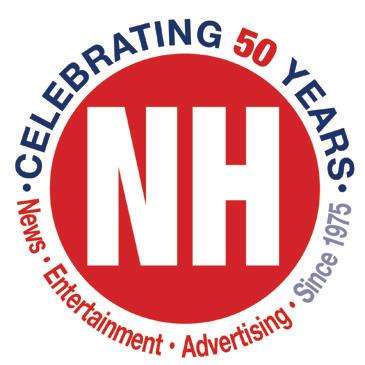
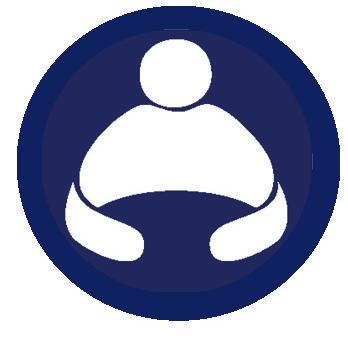



By Leo Adam Biga
Growing up in Nebraska City in the 1960s Bruce Crawford fell in love with the magic of movies on television and at his hometown Pioneer Theatre. Where others’ interest left off his built until he struck up friendships with Hollywood composer Bernard Herrmann in the ‘70s and special effects master Ray Harryhausen in the ’80s. He went on to produce radio film documentaries in the late ‘80s and to present classic film revivals in the ‘90s. The revivals, still ongoing, feature restored prints and guest stars. Each benefits a local charity.
On October 24 Crawford presents his 53rd Omaha film event – the 1972 John Wayne classic, The Cowboys, at the Omaha Community Playhouse to benefit The Jet Award Foundation of Husker legend Johnny Rodgers. Special guest Robert Carradine made his feature debut in the pic. He follows a long line of guests: Harryhausen (Mysterious Island and Jason and the Argonauts); John Landis (Animal House); Patricia Neal (The Day the Earth Stood Still); Shirley Jones (Carousel).
For The Shawshank Redemption revival last May Crawford brought actor Bob Gunton, who played the evil warden. Gunton was

impressed by what he experienced.
“I’ve been to dozens of gatherings related to Shawshank,” he said.
“But Bruce Crawford’s screening was a real ‘barn burner.’ It was thrilling to be seated with 600 passionate fans, watching a pristine copy of the movie, in a spacious but cozy theater. Shawshank is the film I am most proud of being a part of, and to celebrate that with such an
By Andy Bradley Contributing Writer
Numbers can be tedious and dull, like high school trigonometry and calculus classes. But when you pull aside the curtain and peek inside the data, you’re likely to unearth important, critical meaning behind the numbers.
Your blood pressure, for example. Two numbers. 128. 76. The informed person understands that these two
numbers, considered in combination, represent or symbolize the presence of a healthy heart. Here’s another one to consider. 30. More precisely, 30 percent. Astonishingly, that’s the projected growth in the percentage of Nebraskans over age 65 in the 10-year period between 2021 and 2030, according to data from the U.S. Census Bureau’s American Community Survey of 2021. This means the Cornhusker
state’s senior population will exceed 20 percent of the state’s total population in just five years. Interesting for sure. Startling, perhaps. But so what? We’ve heard about the aging of American society for years. Perhaps we’ve grown indifferent to this reality and even more disinterested in the meaning behind the numbers.
So, what precisely is the meaning behind
--Nebraska continued on page 10.
enthusiastic crowd, well, it doesn’t get much better. Special shout out to Bruce Crawford – such a savvy filmgoer connecting so many for so many years to the world of movies.”
The impresario in Crawford doesn’t stop at getting stars to come. He arranges for klieg lights and red carpet treatment as he and special guests arrive in formal attire via limos and paparazzi snap photos.
The lobby is festooned with posters and displays from the feature attraction. After the screening audience members are invited to line up to get autographs and take selfies with the guest star.
Carradine comes from “Hollywood royalty,” said Crawford, referring to Robert being the youngest of an acting dynasty – from father John to brothers David and Keith. Carradine said on The Cowboys he suggested a line reading to Wayne, who proceeded to call his father “a ham” and reduced Robert to tears with choice expletives. He said the overall experience of the film was good and he loves sharing it with fans.
Crawford will also be joined by Brian Downes, director of the John Wayne Birthplace & Museum in the iconic actor’s hometown of Winterset, Iowa.
“Brian has the actual saddle John Wayne rode in The Cowboys and we’re going to have it on display in the lobby,” said Crawford. “That’s showmanship. Anybody can show an old movie or bring back a celebrity and have people talk. You’ve got to do more than that. To make it a real event you’ve got to make
--Crawford continued on page 9.

Whether you’re focusing on your favorite player, team, or a specific era, the collecting sports cards offers a unique way to connect with the world of sports and potentially even invest in appreciating assets. Learn more about sports collections on Page 16.
You’re invited to visit the Millard Senior Center at Montclair, 2304 S. 135th Ave., this month for the following:
• October 1: Board Meeting @ 9:45 a.m.
• October 3, 7, 10, 14 & 28: UNMC Nursing students visiting
• October 6: Bunco @ 12:15 p.m.
• October 8: P.A.W.S (Puzzles & Words with Seniors) @ 9:45 a.m.
• October 8: Sewing Club meet to make sun dresses and shorts at home that are donated and distributed to several countries @ 9:30 a.m.
• October 13: Center is Closed for Columbus Day
• October 27: Book Club “What Moves the Dead” by T. Kingfisher @1 p.m.
• October 28: Halloween Party and Lunch @ 11 a.m.
Tai Chi on Mondays and Fridays @ 9:30 a.m. Bingo every Tuesday and Friday @ 12 p.m. Sportswear Fridays. Wear your favorite team attire every Friday.
Hand-N-Foot Wednesdays @ 8:30 a.m.
MahJongg Wednesdays @ 1 p.m.
Chair Volleyball Thursdays @ 9:30 a.m.
Dominoes Thursdays @ 12:30 p.m.
For more information, please call 402-546-1270.
The Omaha Fire Department’s Public Education and Affairs Department will install free smoke and/or carbon monoxide detectors inside the residences of area homeowners.
To have a free smoke and/or carbon monoxide detector installed inside your home, send your name, address, and telephone number to the Omaha Fire Department for smoke, carbon and monoxide requests at 1516 Jackson St. in Omaha, Nebraska 68102.
For more information, please call 402-444-3560.
The River City Theatre Organ Society is hosting its annual concert at the Rose Theater, 2001 Farnam St., on Sunday, November 2 at 2 p.m.
Theatre pipe organist Nick Renkosik will be the featured guest performer. The concert will include a Buster Keaton Silent comedy “One Week” accompanied by the organist.
Tickets are available at the door the day of the concert for $20.
For more information, log on to rctos.com (Events) or call 402-421-1356.

There’s plenty of information out there about the so-called joys of aging, like creaky bones, hours of lying awake, or having to be near a bathroom at all times. But a lot of the information doesn’t go far enough. It stops at the negative, “Don’t get old, it’s no fun,” when the reality is: Most of these aging changes are par for the course (and may not be nearly as bad as they sound or seem). And—best news of all—they don’t have to keep you from the joy of hobbies, grandchildren, or other enriching life activities.
If you can’t sleep through the night the way you used to, don’t lose sleep over it. Changes to these patterns are a normal part of aging, along with a natural shift in energy levels.
Consider your current sleep habits and create a routine that encourages rest (remember, resting your aging body might not always mean sleeping for 8 hours straight—and that’s OK). We created a sleep hygiene guide for you to understand these changes better, and to provide ideas for establishing new rhythms.
It’s understandable to be concerned when you find yourself hating foods you’ve always loved, or noticing that the pounds stick around more than they used to. Changes in taste and diet, as well as changes in metabolism, are normal aging symptoms.
One piece of nutrition advice that never gets old? Drink. More. Water. Hydration remains a hugely important key to good health for the aging body and really, any body.
Nutrient-rich foods and a healthy diet help too, and our team of knowledgeable nutritionists have created numerous recipes and resources to support you in making some dietary adjustments around the table.
Aches, pains, stiffness: The musculoskeletal system absorbs the effects of wear and tear on the body over time, but it’s not always cause for alarm.
Gentle stretching and regular walking (as opposed to staying sedentary for long
periods of time) are positive antidotes to all things arthritis and age-related aches and pains.
Changes to the hormonal systems (decreased production of bone-boosting hormones like estrogen, for example), chronic conditions, vitamin D and calcium deficiencies, physical inactivity, genetics, and a number of other things can play a part in the weakening of bones as you add more candles to your cake each year.
Finding yourself running to the restroom every time you’re running errands? Or scanning the scene at a social outing to make sure there’s a bathroom close by? You’re not alone.
Nearly half of older women experience reduced bladder capacity and increased urgency, and up to 30 percent of older men experience similar challenges.
As your bladder muscles weaken with age, your ability to control the urge to use the bathroom—and to get there on time when you have to go—becomes more difficult.
A weakened bladder and the lack of estrogen (primarily for women) also contributes to an increased risk of infection.
That’s why UTIs—urinary tract infections—are one of the top reasons older adults head to the ER. Left untreated, UTIs can cause severe pain, discomfort, dehydration, and delirium and dementia-like symptoms that seem to emerge almost overnight.
The longer you’ve lived, the more you might know when something feels off. If you’re still learning how to listen to your body’s signals, that’s OK too.
Nevertheless, there are times when your aging body is telling you something you need to share with your doctor (and self-diagnosis through WebMD doesn’t count). Here, we’ll take a look at 5 reasons to call your doctor and talk things through:
1. Persistent pain: You tried your go-to pain relievers, yet you’re still uncomfortable or unable to move,
function, or sleep without relief.
2. A rash that doesn’t go away: Your skin is your largest organ. When something is going awry in your body, it may show up there. If your usual means of treating skin issues aren’t working—or if the rash is worsening over time—call your provider.
3. Sudden, significant weight loss: Most people are happy to drop a few pounds, but it isn’t always a reason to celebrate—especially if it was a drastic amount in a short period of time, or if you hadn’t done anything differently (extreme diet or exercise changes) to cause it.
4. Fatigue that doesn’t improve with sleep: Being tired from chasing the dogs or post-work hobbies is one thing, but not being able to stay awake even after nights of good, restful sleep is another. Talk to your doctor when the fatigue is preventing you from keeping up with your usual schedule and daily to-dos.
5. Dizziness, increased falls/balance issues, or changes in vision that don’t improve: These are all things that can indicate your vestibular system is not performing as it should, not something to wave off as “just getting older.”
Many people panic at the first sign of a lapse in memory, resigning themselves to a case of early onset Alzheimer’s. But while there are some agerelated changes to the brain that can impact memory and cognitive function, memory loss is not a normal part of aging.
Your brain changes with age—so while it may be harder to remember where you put your keys or recall the name of your new neighbor you met yesterday, that doesn’t mean you’re on the road to dementia. Mild forgetfulness and trouble recalling information quickly are normal aging symptoms.
A Word from ArchWell Health: Wherever you are on the memory loss journey, you are not alone. The compassionate team at ArchWell Health is always ready to assist caregivers and older adults with their primary care needs.
As September flows into October, I look forward to enjoying this beautiful season with its vivid colors and mild temperatures. It is a wonderful time to enjoy the outdoors. Along with poets and spiritual writers, I look to creation as a source of inspiration and learning.
Daily walks with my dog inevitably lift my spirit. Irrepressible life forces continue forward, no matter what is happening among nations and political entities. Drinking in the blue sky peeking through the green leaves reminds me of how small we are in comparison with the whole earth and universe. In the garden I cherish the ripening vegetables and vibrant sunflowers. Nature is truly miraculous. Perhaps that is why I am so bothered by cans, candy wrappers, and other trash that litters roadsides. Whoever litters the face of Mother Earth does not value her beauty and giftedness. Unfortunately, many do not recognize their responsibility in caring for our common home. With every privilege comes responsibilities. Marring the gift of nature depletes our environment and
By Nancy Hemesath
interferes with our ability to enjoy creation.
Those of us who have lived many decades remember a time when it seemed that the resources of fertile land, clean water and air were endless. As a child it never occurred to me that we would run out of these natural blessings. We took it all for granted. We have learned in recent decades that this is far from the truth.
As my appreciation for creation deepens and my awareness of the fragility of the earth increases, I am motivated to be an advocate for the environment. We share one planet, one that will need to sustain life for future generations of my family and all families. If we do not do our part to protect this earth, we are burdening future generations with diminished living conditions which will harm them and, perhaps, even destroy their lives. As an elder, I take this responsibility seriously.
This responsibility boils down to small things. I advocate for earth-friendly policies with elected representatives. I choose sustainable or biodegradable products when I have a choice. I avoid single use plastics and recycle what I purchase, including the use of orange bags for some plastics. I compost food waste, so it goes back into soil instead of emitting carbon dioxide from landfills. These are minor in the big picture, and I need to do more. Still, if we are conscious of the earth and if we all do a little bit, our accumulated efforts will make a real difference for our kids and grandkids. This is one of our gifts for future generations, the gift that matters the most.
(Hemesath is the owner of Encore Coaching. She is dedicated to supporting people in their Third Chapter of Life and is available for presentations. Contact her at nanhemesath@gmail. com.)
For some, the first meal of the day is a smoothie, while others enjoy toast. Other options may be miso soup, chilaquiles or—for the particularly daring—blood sausage.
When someone first told you that breakfast is the most important meal of the day, did you just take their word for it?
Check out these facts to start your Better Breakfast Month off on the right foot. Why does breakfast matter? Even if it’s a grab-andgo apple or a last-second bagel as you head out the door, eating breakfast regulates your blood sugar, thus helping you combat stress, irritableness, brain fog and dips in energy.
Breakfast is crucial, especially for older adults, as it ensures nutritional needs are being met, keeps energy levels consistent throughout
the day and can prevent the nauseating effects of taking morning meds or vitamins on an empty stomach.
Breakfast deniers may also face long-term health risks such as iffy metabolism and heart disease.
If you have trouble eating in the early hours, don’t fret—a mid-morning meal can be just as beneficial! I don’t want better breakfast, I want the BEST. What should I eat? Get familiar with the tasty morning trinity: Protein, fiber and fat. Implementing this trio into your morning meal won’t just keep you fuller longer, it’ll also improve your gut health and aid your digestion throughout the entire day.
Examples of this phenomenon: A greek yogurt parfait, an egg and veggie scramble or a breakfast sandwich with greens. Don’t have the time

to prepare a meal before you hit the road?
Try prepping overnight oats the night before, blend up a quick smoothie or grab a store-bought granola bar with mindful ingredients. Fuel up with what feels right to you and your body. Is my morning coffee part of a balanced breakfast? Hold off on the joe for an hour or so—the best beverage to start your day is a cup of water.
If plain water doesn’t strike your fancy, add a splash of juice or a few slices of fruit, like lemon or lime.
If all the inspiration is too much for one meal, don’t forget that breakfast for dinner is another option—and it’s just as fulfilling.
This health tip is brought to you by Tabitha.
New Horizons is the official publication of the Eastern Nebraska Office on Aging. The paper is distributed free to people over age 60 in Douglas, Sarpy, Dodge, Washington, and Cass counties. Those living outside the five-county region may subscribe for $5 annually. Address all correspondence to: Ron Petersen, Editor, 4780 S. 131st Street, Omaha, NE 68137-1822. Phone 402-444-6654. FAX 402-444-3076. E-mail: ron.petersen@enoa.org
Advertisements appearing in New Horizons do not imply endorsement of the advertiser by the Eastern Nebraska Office on Aging. However, complaints about advertisers will be reviewed and, if warranted, their advertising discontinued. Display and insert advertising rates available on request. Open rates are commissionable, with discounts for extended runs. Circulation is 9,000 through direct mail .
Editor................................Ron Petersen, 402-444-6654 Ad Mgr................Mitch Laudenback, 402-444-4148
Contributing Writers.........Leo Biga & Andy Bradley
ENOA Board of Governors: Mary Ann Borgeson, Douglas County, chairperson; Don Kelly, Sarpy County, vice-chairperson; Lisa Kramer, Washington County, secretary; Pat Tawney, Dodge County, & Taylor Boyle, Cass County.
The New Horizons and the Eastern Nebraska Office on Aging (ENOA) complies with applicable federal civil rights laws and does not exclude, deny services to, or otherwise discriminate against any person on the basis of race, color, national origin, disability, age, sex, marital status, veteran status, or religion.
It’s that time of year again—the Medicare Annual Election Period. Between the commercials, mailings, and endless chatter on social media, it can all feel overwhelming. The good news? You don’t have to figure it out alone. Here are some reasons why so many people love working with a local, independent licensed agent:
INDEPENDENT & UNBIASED ADVICE
• Independent agents work for you—not the insurance companies.
• There is no fee for their services, and your cost is the same whether you use an agent or not.
• Commissions are generally the same across plans, and some plans (like certain prescription drug plans) pay no commission at all—yet if you have a dedicated agent for your Medicare supplement, they may still help you enroll in a drug plan if it’s the right fit.
• Tax dollars are not used to run an independent agent’s office.
TRAINED & CERTIFIED
• Agents must first earn a state Life & Health Insurance license before they even navigate towards Medicare.
• They complete regular



• One Floor Living
• Open Concept” design – easy traffic flow
• Step-less Front Door & Garage Entries
• Wider Hallways
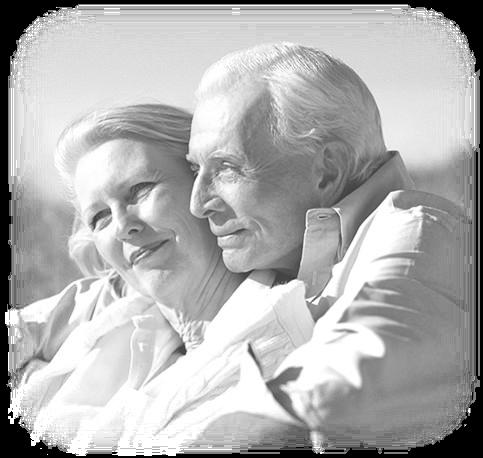
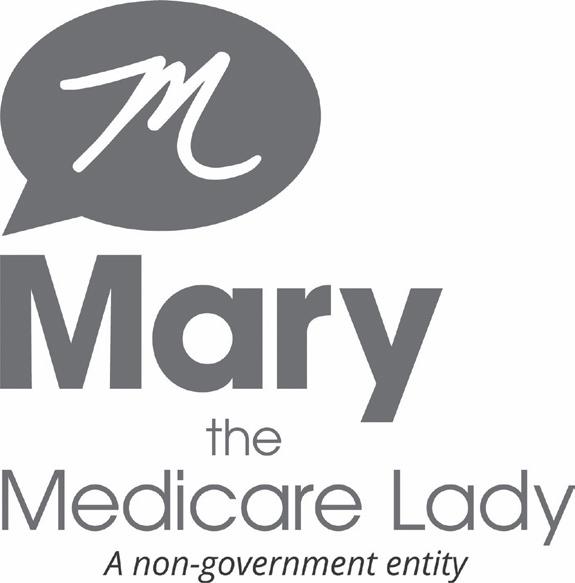
Continuing Education and Ethics training to keep that license active.
• Each year, agents must pass a national Medicare exam (such as AHIP or NABIP)
• Each year they spend additional hours certifying with each carrier they represent.
• They attend ongoing trainings, webinars, and local meetings to stay on top of plan changes.
• Independent agents know the plans in your local market and have direct contacts with carrier representatives—so they can advocate for you if issues come up.
• They’ll alert you to important changes in your plan. For Example: last year a carrier dropped dental coverage beyond cleanings and exams—clients without an agent didn’t realize that until they were at the Dentist’s office facing big bills.
Another carrier went out of network with a local medical provider. Agents keep track of the plans their clients are enrolled in and will reach out to you to make sure you’re protected.
• They’ll screen for financial assistance qualifications and direct you to proper organizations.
Agents can enroll you in the Medicare Supplement/ Medigap, Medicare Drug, or Medicare Advantage plans that you want, and also help you protect any gaps with:
• Dental, Vision, and Hearing plans
• Hospital Indemnity coverage
• And more—depending on your needs
PROTECTION & PROFESSIONALISM
• Agents carry Errors & Omissions insurance to protect both you and themselves.
• They use specialized software to compare plan pricing, rate history, and loss ratios so you can make an informed choice.
• They know about the yearly changes from CMS (Center for Medicaid and Medicare Services) and how to navigate them.
• They’re members of Professional Organizations and Facebook groups and help support and educate each other.
CONVENIENCE & PERSONAL SERVICE
• Schedule appointments in person, by phone, or over Zoom—whatever works best for you.
• Agents can even speak with your doctor or dentist’s office on your behalf if issues arise.
• They’ll remind you to use the ancillary benefits your plan includes.
• They keep track of when it’s time for you to review all of your coverages, not just Medicare.
benefits not covered under original Medicare. The only way that you will be able to continue to receive this benefit is if you are on full Medicaid and have a qualifying Chronic condition such as diabetes, chronic heart failure and cardiovascular disorders. Feel free to reach out for a list of the qualifying conditions that will allow you to keep these additional benefits.
There is a Medicare plan expanding into the Omaha metro in 2026 that historically has star ratings above the industry average. (CMS uses a 5 star quality rating system.) In addition, they are offering Chronic Special Needs plans which is a first for the Omaha metro. Make sure your agent shows you all the local options available to you so you can see if it’s a good fit or not. Don’t wait until the last minute to schedule your appointment. New plan information comes out October 1st, but you can’t make any changes until Oct 15th through Dec 7th.
Medicare is complex, but you don’t have to navigate it alone. A local, independent licensed agent can make sure you’re informed, protected, and confident in your coverage not only at the Annual Election Period, but throughout the year. If you’d like a free review of your Medicare options, reach out to a local independent agent this Annual Election Period.
Homes designed with your future in mind! Open concept floor plans with “Universal Design”* standards
• Wider Doorways (most doors)
• Low-Curb or Zero-entry (per plan) Shower Access
• Low Maintenance Exteriors
• Available in over 20 Communities
Locations available in all parts of the Omaha area For NW/Elkhorn Living: 402-916-9883 For SW/Gretna Living: 402-895-1100 For Papillion Living: 402-896-9200 For Bellevue Living: 402-614-6088

www.RegencyHomesOmaha.com
*This is Universal Design; not ADA Standards.

• They’re members of your local community and support Chambers of Commerce and other civic organizations.
• Each year, your agent reviews your prescriptions, doctors, health needs, and budget to make sure you’re still on the best plan.
• You’ll talk to the same agent every year— someone who knows you personally and understands your medical and financial history.
ENROLLMENT BEYOND MEDICARE
There are plenty of experienced, independent agents in your area—you just need to find the one that feels like the best fit.
When choosing an agent, make sure they show you their computer screen and can provide an estimate of your annual prescription costs on different plans. This feature isn’t always available on public quoting sites, but good agents have the tools to do it.
If you are on both Medicare Advantage and full Medicaid, unless you have a qualifying Chronic condition, CMS will no longer allow Medicare Advantage plans to offer some of the additional
Mary Hiatt is a Retirement & Insurance Advisor and President of Mary the Medicare Lady (A nongovernment entity.) She is Certified in Long Term Care Programs, Policies, & Partnerships and Annuities. She offers Educational Workshops on Medicare, Long Term Care and more at no charge. She works with reputable estate planning Attorneys to help her clients get Medicaid. Not connected with or endorsed by the U.S. government or the federal Medicare program. Medicare Supplement insurance plans are not connected with or endorsed by the U.S. government or the federal Medicare program.
By Ron Petersen
Arlington Senior Center located at 305 N 3rd St. in Arlington is this month’s Senior Center of the Month.
Arlington Senior Center manager Cheryl Abbot has been a manager at the center for 13 years. Abbot said that the participants love and support each other.
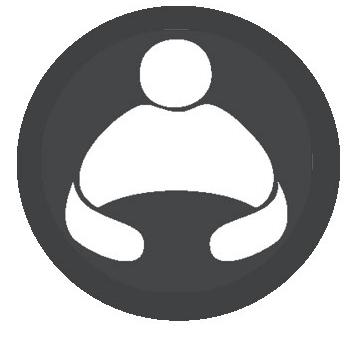
“They have found friendship at the center,” Abbot said.
Arlington hosts plenty of activities in-
cluding bingo, crafts, dominoes and more entertainment. There is also a Supper Club on the 1st and 3rd Tuesday of the month.
While they have plenty of opportunities for activities, they are always looking for more participation.
“More participation and people exploring is what keeps the center thriving,” Abbot said.
For more information about the center, please reach out to Abbot at 402-478-4774.
The Arlington Senior Center is open Monday through Fridays from 8:30 a.m. to 1:30 p.m.
By Tony Harris AARP NE Information Center
Every second counts when someone is having a stroke. Do you know the signs? Would you know what to do?
Whether you’re a caregiver, a concerned neighbor, or simply someone who wants to be prepared, this program is a must-attend. Because when stroke strikes, knowing what to do—and doing it fast—can save a life.
On October 15 at 1:30 p.m., anyone is invited to attend the AARP Nebraska Information Center’s monthly program, where anyone can

learn about stroke response. Courtney Marquiss, Immanuel and Mercy Council Bluffs Stroke Program Coordinator, will lead this engaging discussion. The program promises to be both informative and engaging, with refreshments served and opportunities to ask questions and connect with others in the community.
Located at 1941 S 42nd St. in Suite 220, the Information Center is open on Tuesdays, Wednesdays and Thursdays from 10 a.m. until 4 p.m. If you are interested in
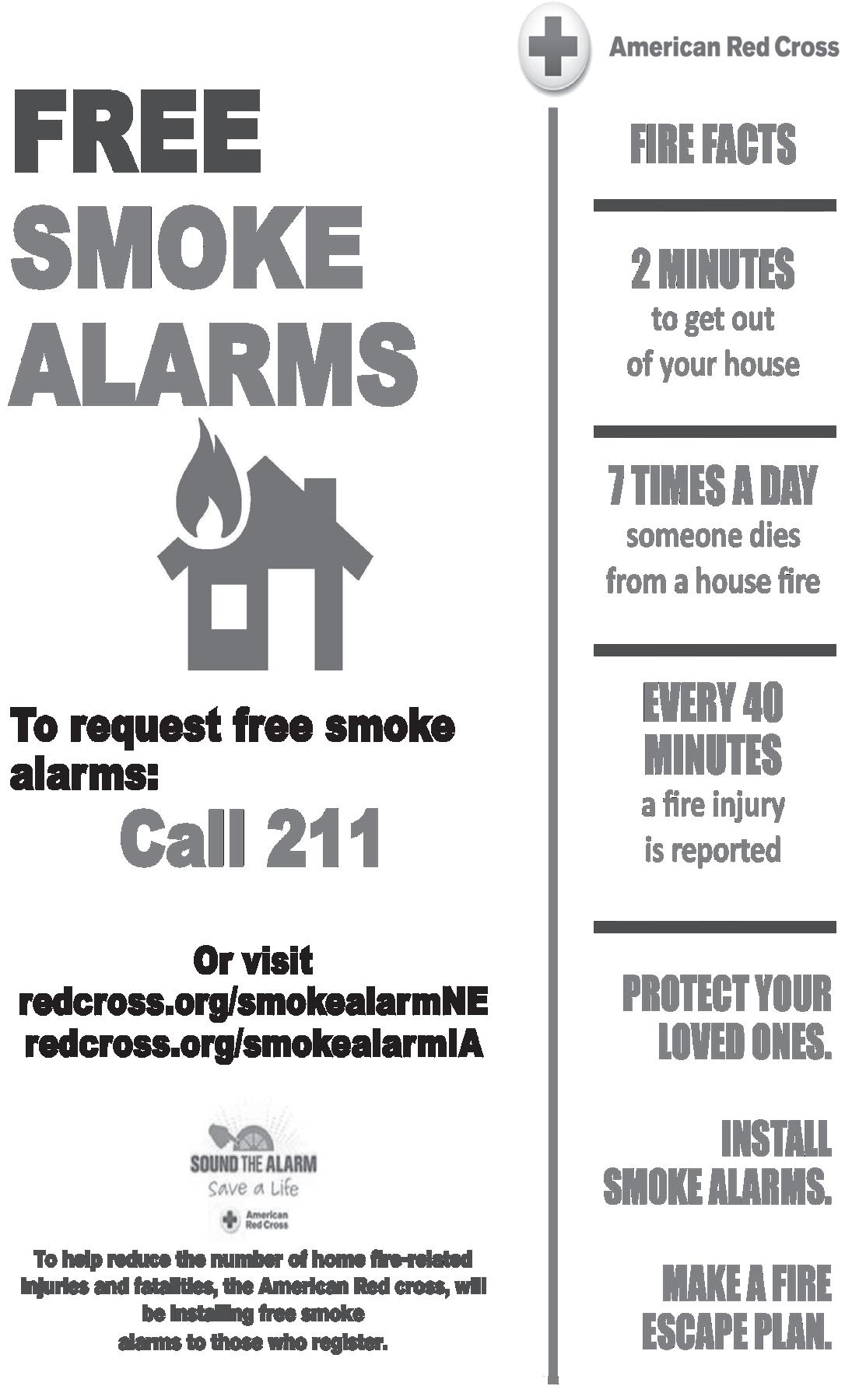
ou’re invited to visit the La Vista Senior Center, located at 8116 Park View Blvd. The facility provides activity programs and meals Monday through Friday from 8 a.m. to 5 p.m. Please call 402-331-3455 for general Community Center hours.
Meals are served weekdays at 11:30 a.m. Reservations are due by noon the business day prior to the date the participant wishes to attend and can be made by calling 402-331-3455.
A $5 contribution is suggested for the meal if you are age 60 and older. If you are under age 60, then the meal cost is $9.50.
In addition to meals being served daily, the La Vista Senior Center offers a variety of activities such as: Bingo, outings, cooking classes, movies with popcorn, arts and crafts, a variety of card games, quilting, Tai Chi, exercise classes, musical entertainment and various parties.
Please visit our website at cityoflavista.org/seniors for updated information or call 402-331-3455.
becoming more involved, stop by the Information Center to learn more about the many opportunities to get involved in the community by becoming an AARP Nebraska volunteer.
For more information call the Information Center at 402-916-9309.


$15
Alfie Allen
$5
Barbara Hopkins
You’re invited to visit the Camelot Friendship Center, 9270 Cady Ave., for regular activities, which include Chair Yoga, card games, Tai Chi, Pinochle, 10 Point Pitch, and bingo. This month’s events include:
• October 8: Presentation on Medicare with Jinnifer James @ 11:45 a.m.
• October 9: Heather with Amana Care will call Bingo @ 11:45 a.m.
• October 13: Presentation by Teresa Hamer with “Smart Gen Society” @ 11:45 a.m.
• October 14: Entertainment with Joyce Trochia from Merrymakers @ 11:45 a.m.
• October 16: Jackpot Bingo @ 12:15 p.m.
• October 22: Harvest Luncheon Fundraiser
• October 30: Team Trivia Challenge @ 12 p.m.
• October 31: Halloween Party @ 11 a.m.
Every Monday – Card Game: Manipulation @ 10 a.m.
Every Monday – Pickleball @ 10 a.m.
Every Monday and Friday – Bingocize @ 10 a.m.
Every Tuesday, Wednesday and Thursday – Kings in the Corner @ 10 a.m.
Every Wednesday – Chair Volleyball @ 10 a.m.
Everyday – Card Games @ 10 a.m.
Grab N Go meals are available.
For more information, contact Barb at 402-444-3091 or barbara.white@cityofomaha.org.
The University of Nebraska Omaha Gerontology Department is recruiting family caregivers for older adults with dementia.
The study includes two in person visits of approximately 9.25 hours total that will take place at the University of Nebraska Medical Center (UNMC). This study is a clinical trial that involves receiving intranasal oxytocin or a placebo. The Study involves completing tasks, questionnaires, interviews, brain imaging, and saliva collection. Compensation for study participation is available.
You may qualify if you are 50 years of age or older, female, right-handed and are a current unpaid family caregiver to an older adult (50 years and older) with dementia for at least five hours a week and for at least six consecutive months. You must have comprehension of written and spoken English, a normal or corrected to normal hearing and vision and have mobility to travel to the University of Nebraska Medical Center.
You may not qualify if you have a major medical illness that would prevent oxytocin administration or allergic reaction oxytocin spray product; if you are in a current central nervous system illness or other serious major medical illness; if you have Neurological disease (e.g., stroke), or drug/alcohol abuse; if you have a severe psychiatric disease; if vision, hearing, cognitive, or motor difficulties; if you are currently pregnant, planning to become pregnant soon, or breastfeeding; if there is a metal implanted in the body that would prohibit brain imaging; or if you are currently taking anti-psychotic medication, SSRI’s or corticosteroid creams/pills.
If you are interested, please call Janelle Beadle at 402554-5961 or email at beadlelab@unomaha.edu.
While everyone has the right to age well, women face unique challenges to aging with optimal health and economic security. These include:
• Problems with health and health care access
• Caregiving responsibilities that can drain health and retirement security
• Lower participation in employer-sponsored retirement plans
Women often make less money than men; they often work part time, take time away from work to
care for children and aging parents, save less money, work in fields with fewer employer-sponsored retirement benefits, have more chronic diseases with their related costs, and feel less comfortable discussing finances.
Know some key facts about women and aging so you can help be part of the solution. Women and health care access include:
• Overall, 10% of women said they didn’t see a doctor because of the costs. Hispanic and American In-
dian/Alaska Native women are most likely to say they didn’t see a doctor due to costs and white women are the least likely.
• In 2021, 3 out of 4 women age 65+ with Medicare had a mammogram in the past 2 years. Screening rates were highest (82%) among Black women and lowest (59%) among American Indian/Alaska Native women.
(Information provided by The National Council on Aging).
Looking into the myth that nursing homes will ‘take all your money’
By Lois Jordan
One of the most common misconceptions about nursing homes and assisted living communities is the belief that “they take all your money.” Families often approach long-term care with fear that a parent’s or loved one’s entire life savings will be gone overnight. In reality, this belief is not only inaccurate but also misleading- and it can prevent people from planning properly for care needs later in life.
Paying for care is like paying for housing. Living in a nursing home or assisted living community is no different than paying rent for an apartment or making a mortgage payment on a house. Regardless of where you live, you must pay for your housing.
The difference is that in a senior living setting, the monthly payment goes beyond just a roof and four walls. It covers meals, housekeeping, utilities, maintenance, activities, and most importantly, supportive services that you would otherwise have to arrange and pay for separately at home.
Think about it this way: If you remained in your own home, you would still pay property taxes or rent, utilities, groceries, lawn care, repairs, and potentially in-home help. When you add these costs together, the expenses often match or even exceed the
monthly cost of assisted living or nursing home care, especially once 24-hour support becomes necessary.
Another source of confusion is government programs. Many assume that Medicare and Medicaid will cover all senior living expenses, but that’s not how the programs are designed.
• Medicare is health insurance, primarily covering medical care, hospital stays, rehabilitation, and limited skilled nursing services. It does not pay for longterm room and board in a nursing home or assisted living facility.
• Medicaid is intended as a safety net for those with limited income and assets. It may cover some expenses related to long-term care in certain facilities, but it requires meeting strict financial and medical eligibility criteria. Even then, it does not cover every expense or provide the same level of choice and amenities as private payment.
Expecting either program to cover the full cost of daily living, housing, and personal services is unrealistic and unfair to the care communities themselves. Just as people budget for housing, food, and healthcare expenses throughout their lives, long-term care is another cost to plan for.
So, let’s shift the perspective. Instead of
viewing nursing homes or assisted living as settings that “take” money, it’s more accurate to see them as providers of comprehensive housing and care. Families are not being charged for “existing”; they are paying for shelter, meals, staffing, safety, medical oversight, assistance, and peace of mind.
The reality is this: senior living is a service, not a seizure of assets. Just as you would never expect your landlord, bank, or utility company to provide housing and services for free, it’s not realistic to assume nursing homes and assisted living should either.
The myth that nursing homes and assisted living communities “take all your money” has caused unnecessary fear for countless families. In truth, these costs are simply the price of housing and services consolidated into one setting, just like any other living arrangement. Understanding this allows families to plan realistically, appreciate the value of the care provided, and focus on what matters most: quality of life, dignity, and safety for their loved ones.
Lois Jordan, CEO for Midwest Geriatrics Inc. Management company for Florence Home Healthcare Center, Royale Oaks, and House of Hope Assisted Living and Memory Care
You’re invited to visit the Fremont Friendship Center, 1730 W. 16th St. (Christensen Field). The facility is open Monday through Thursday from 9 a.m. to 3 p.m. and Friday from 9 a.m. to 12:30 p.m.
A meal is served weekdays @ 11:30 a.m. Reservations, which are due by noon the business day prior to the meal the participant wishes to enjoy, can be made by calling 402727-2815. A $5 contribution is suggested for the meal. This month’s activities will include:
• October 1: Music with Tim Javorsky @ 10:30 a.m.
• October 2: Nye Presentation @ 10 a.m.
• October 8: Music with Bill Chrastil @ 10 a.m.
• October 9: “Medication Safety”-Miller Pharmacy and Visiting Angels @ 10 a.m.
• October 15: Merry Maker’s presents music with Kim Eames @ 10:30 a.m.
• October 16: Presentation wtih May Museum @ 10 a.m.
• October 21: Casino Trip to Blackbird Bend in Onawa
• October 22: Hippie Day! Music from the 60’s and 70’s with Pam Kragt @ 10:30 a.m.
• October 23: Parkinson’s Foundation Presentation @ 10 a.m.
• October 28: Board Meeting @ 1:30 p.m.
• October 29: Music with The Links! @ 10 a.m.
• October 30: Meet Phinehas the Comfort Dog and hear about the ministry @ 10 a.m.
Craft class on Tuesday afternoons @ 1:30 p.m.
Tai Chi offered every Tuesday and Friday from 9:15-10 a.m.
If you can’t stay for lunch with our friends and you currently participate in any activity at the center, you may now order a Grab-n-Go meal to take home for your lunch. Grabn-Go meals must be reserved the day before by noon and the person ordering the lunch must come in to the center to pick it up at 11 a.m. The number of Grab-n-Go lunches are limited to a first come first serve basis. Suggested donation is $5.
For meal reservations and more information, please call Laurie at 402-727-2815.
You’re invited to visit the Intercultural Senior Center (ISC), 5545 Center St.
The Intercultural Senior Center facility – open weekdays from 8 a.m. to 4:30 p.m. – offers programs and activities Monday to Friday.
Come and exercise at the ISC. It’s never too late to learn and have fun. Join their language classes, technology, jewelry and crafts, and field trip options.
For more information, please call 402-444-6529 or visit the ISC website at interculturalseniorcenter.org.
First United Methodist Church has some excellent adult curriculums available. They are free for any Christian group which would like to study prayer, discipleship and beliefs.
Call First United Methodist Church at 402-556-6262 if you wish to receive more information about the list of the studies available.
Legal Aid of Nebraska operates a free telephone access line for Nebraskans ages 60 and older.
Information is offered to help the state’s older men and women with questions on topics like bankruptcy, Homestead Exemptions, powers of attorney, Medicare, Medicaid, and Section 8 housing.
The number for the Elder Access Line is 402-827-5656 in Omaha and 1-800-527-7249 statewide.
This service is available to Nebraskans ages 60 and older regardless of income, race, or ethnicity.
The Legal Aid of Nebraska hours of operation are 9 a.m. to noon and 1 to 3 p.m. Monday through Thursday, and 9 a.m. to noon on Friday.



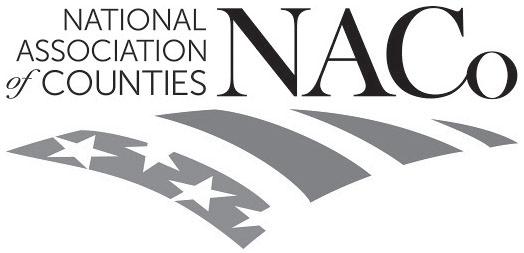
By Ron Petersen
Omaha Metro Transit is now offering rides on its new microtransit system, Metro Flex, as they are taking another step in removing barriers by adding to the transportation options.
The program relies on 18 shuttle vans that can carry up to five passengers at a time and includes six wheelchair-accessible vans.
The shuttles will offer shared rides around a North Zone, South Zone and West Zone in Omaha to help expand available public transportation currently offered.
Each zone also has at least one transit center, providing access to key connections across Omaha.
Riders will be able to request on-demand rides when they’re within one of

In August, Metro Flex, an on-demand, app-based public transit pilot service in partnership with Via, a global leader in microtransit service was added to the Omaha microtransit system.
the three zones and go anywhere within the zone they requested the ride in.
If they want to get to an-
other zone, they can connect to a bus route to finish the trip.
“This service will be
transformational for many, providing greater mobility and enhancing transportation options for Omaha

residents. In Omaha and eastern Nebraska, we are working every day to create a more connected and accessible community and publicprivate partnership. Efforts like this take us even closer to our ultimate goal,” Heath Mello, President & CEO of the Greater Omaha Chamber, said in a press release.
Any Omaha rider can call for a ride using Metro Flex in the app or by calling the customer service line at 402-341-0800 to get a ride around the three zones.
Riders may have to wait a little for their pickup, and they may share the ride with other passengers. The app programs the driver routes to pick up several passengers as needed.
“Metro Flex takes the best of the tech world and melds it with the promises public transit provides to deliver a flexible service that will help Omaha and the overall metro region grow into the future,” Curt Simon, Board Chair for the Regional Metropolitan Transit Authority of Omaha, said in a press release. “It fills important gaps, making it easier for people to reach jobs, school, healthcare and more.”
The service is available Monday – Friday from 6 a.m. to 9 p.m., Saturday from 7 a.m. to 8 p.m., and Sunday from 8 a.m. to 6 p.m. Starting on October 15, rides will cost $3.
You’re invited to visit the Florence Senior Center, 2920 Bondesson St. At the Florence Senior Center, lunch is served at 11:30 am. A select menu is offered Monday thru Friday. Meal reservations must be made one day in advance. Please call by noon the day before for a meal reservation.



There will be a painting workshop with Kim Darling at 9 a.m. every Wednesday in October, November and December. In October, Florence will host a Smart Gen Society presentation on staying safe online.



The center hosts activites such as Tai Chi, special guest speakers and socials. Arts and crafts will be held on the third Wednesday of each month. They also provide health and nutrition programs.
For more information, please call Colleen Metz @ 402-444-6333.
continued from page 1.
a show out of it. I think so anyway.”
Crawford said he’s excited to present one of The Duke’s “greatest films and one of the best westerns ever,” adding, “I don’t think it’s a big leap to say he’s probably the most famous movie star of all time with his ruggedness, larger-thanlife quality and gravitas.”
The Cowboys is famous for its rousing John Williams score and for being the first time a Wayne character was killed on screen. It’s the fourth Wayne flick Crawford’s featured after The Searchers, The Man Who Shot Liberty Valance and McLintock!.
The Nebraskan has earned a national reputation as historian and promoter. What began as simple fandom has turned into a life and career devoted to celebrating films and filmmakers. He never imagined his enthusiasm would lead to all this.
“Are you kidding? Of course not, it’s unheard of. I had no idea,” he said. “When I first started doing this I thought it might go five or ten events. I never thought it would go beyond that.”
Similarly, he never thought he could make a living sharing his passion with others.
“It’s been a full-time thing for me since 1992. I can focus entirely on each event without worrying about paying the bills somewhere else. It’s just been an amazing run. I’m all selfsustaining. I have a good team of people that help out logistically the night of the events and others help with press releases and promos, but everything else is pretty much handled by myself.”
He’s in a tradition of maverick moviemakers, promoters, exhibitors. Wahoo’s Darryl F. Zanuck, a studio mogul in Hollywood’s Golden Age, became an independent producer. Omaha native Alexander Payne has carved out an Indiewood career that’s seen him shoot some of his Oscar-contending films in Nebraska. Just as those projects, along with film studies programs, art cinemas and festivals enrich the film culture, Crawford does, to – only his way.
“Independence gives you freedom of mind to go the way you feel is appropriate for you and not go the way that everybody else thinks you should,” he said.
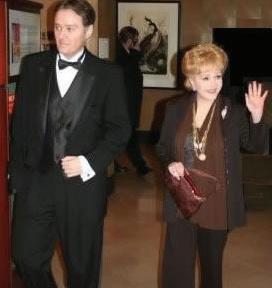
Indulging his passion almost makes it seem as if it’s not work. Said Crawford, “It’s a true statement when they say that if you do something you love it’s never really work. I mean, it is hard work, it’s not easy to do, but because it’s something I love there’s no drudgery. It’s been very rewarding.”
His work’s not gone unnoticed. Turner Classic Movies (TCM) host Ben Mankiewicz, who joined Crawford for a screening of Raiders of the Lost Ark, said, “Everyone associated with Omaha Film Event, starting with Bruce Crawford, is a professional — and a passionate professional at that. There’s nothing quite like bringing a classic movie to a group of eager cinephiles like I got to meet in Omaha.”
“The recognition is always nice especially from Turner Classic Movies, AFI (American Film Institute), but I don’t do it for those reasons,” Crawford said. “I do it because I love it. It’s just fun to do. And it expresses who I am.”
When the site of his very first film event and of several that followed, the Indian Hills Theatre, was slated for the rubble heap Crawford helped lead efforts to try and save it. He elicited pleas from movie industry heavyweights but the campaign failed. A parking lot occupies where the Cinerama landmark stood, marking “a sad loss” for movie lovers like him. He’s held events at different venues since then, including the old Cinema Center, the Orpheum Theatre and Joslyn Art Museum. Presenting and viewing film treasures on a big screen is reward enough for Crawford because it means projecting movies the way they’re meant to be seen.
“It is a totally different experience,” he said. “People pooh-pooh that sometimes but once they live it then they know it’s the truth. Many of the films we’ve
shown I’d only seen on TV, I’d never seen them in a theater. Then when I finally see them on a big screen with an audience it is a whole different experience.”
In 1974 Crawford was 16 living at home with his parents when his admiration moved him to handwrite a letter and mail it to the composer.
“Summer and fall went by and I didn’t hear back from him,” Crawford recalled. “Then on a Sunday morning in December my mother woke me up to say, ‘There’s an older man calling wanting to speak with you.’ I was like, ‘What?’ I thought maybe it was a teacher from school. It wasn’t, it was Bernard Herrmann. I said, ‘How did you get my phone number?’ He said he called information and asked for a listing of Crawford in Nebraska City. I was so startled and flabbergasted I could hardly speak. I managed to say, ‘Why’d you bother to call me?’ And he said, ‘Well, why’d you bother to write me?’ ”
Herrmann, who lived in London, called from his brother Louie’s home in their native New York. Crawford enjoyed a few more conversations with the maestro. Each emboldened him. “I just knew this was life changing. I thought if I could talk to this man and be taken seriously then I can talk to anybody.”
Herrmann died unexpectedly the next year having just finished scoring Martin Scorsese’s Taxi Driver. “It was heartbreaking,” Crawford said. The young cinephile became friends with the Herrmann family and remains so over 50 years later. “Isn’t It amazing?
His relationship with the family and with fellow Herrmann devotees helped him convince KIOS-FM Radio’s Bob Coate to collaborate on producing the documentary, Bernard Herrmann A Celebration of His Life and Music. Crawford researched the project, which featured original interviews with Herrmann experts and excerpts from his most beloved movie compositions. The radio doc first aired locally and statewide before reaching a national audience on NPR. Hollywood giants took notice.
“Steven Spielberg, Robert Zemeckis and Bob Gale contacted me wanting copies,” Crawford said. “Because of that I became friends with Bob Gale, who
came back for a 2018 showing of Back to the Future, which he and Zemeckis. co-wrote.”
The other composer he steeped himself in, Miklós Rózsa, became an obsession upon first seeing the Rozsascored, multi-Oscar winning Ben-Hur. Rozsa’s scores for costume epics became a particular fascination of Crawford’s. Just as Herrmann created music for some of Harryhausen’s fantasy films, Rozsa did for The Golden Voyage of Sinbad. Though Crawford never got to know Rozsa personally he and Coate produced a doc on him, Ben-Hur: The Epic Film Scores of Miklós Rózsa. As those composers’ work intersected with that of Harryhausen, it made sense for Crawford to connect with the visual effects pioneer for those docs. A close friendship ensued. “I went to his home in London three or four times and spent a couple weeks each time. I still can’t believe that happened.”
SPECIAL MEMORIES
Crawford takes satisfaction in knowing his tributes have helped ensure the legacies of film greats “whose impact is unquestioned and incalculable.”
“It’s very gratifying. I think it was meant to be.”
Reflecting on his events, he said, “There’s a few that were milestones, led by the first one 33 years ago with Ray Harryhausen. Without that there’d be no events. That was a dream come true. I always loved Ray’s films. They changed my life. After he got his Oscar for life achievement I talked him into coming here. He came and we had a great time. It was a great event.
“It was successful enough that it kicked off my second one, Ben-Hur, which was the big one for me. It got national coverage. Leonard Maltin did a brief piece on it for Entertainment Tonight. The Wall Street Journal had an item about it.”
Helping it get that attention was the fact it was a 35th anniversary tribute to Ben-Hur featuring a newly restored print on the Indian Hills mega screen.
“It was such a unique thing to happen in Omaha.”
After that unqualified success, he said, “I thought, ‘Do I keep doing this or just call it a day.’ My good friend Bill Chvala talked me into doing more. For the 50th anniversary of D-Day we showed the classic The Longest Day (a pet project of Nebraska’s own Darryl
F. Zanuck). The fourth one was with my first big movie star, Janet Leigh, for Psycho.”
He kept reviving movies and the stars and audiences kept coming, until he looked up to find he’s been doing this for three-plus decades.
“It’s been my entire adult work life. It’s given me a life I never dreamed possible.”
In addition to his Omaha events, he’s sometimes invited to be part of programs outside of the state.
“At the Britt Music & Arts Festival in Jacksonville Oregon Kim Novak was with me on stage introducing Herrmann’s music from Vertigo at an amphitheater. It was so surreal.”
His work helping keep American film heritage alive is respected by those with that same mission. TCM’s former host, the late Robert Osborne, was a friend and champion. “He was a great resource for me,” Crawford said.
In 2016 the American Film Institute invited Crawford to speak on Herrmann at the National Gallery of Art. Henry Kissinger was in the audience. As with so many things that have happened to him, Crawford said, “It didn’t seem real. I was there to introduce Herrmann’s music for Hitchcock’s The Wrong Man (starring Nebraskan Henry Fonda) and for an episode of The Twilight Zone, Walking Distance.
Back home, the most frequent questions he gets asked are, What’s next? and Why don’t you do more? He’s constantly thinking about what to show but even though he may have a movie in mind not everything always comes together. With all that goes into planning events it’s not realistic to do more than two a year,” he noted. “It takes six months to put each of these together. It’s all time intensive.”
Looking ahead, he said, “I don’t know if I have another 53 in me or not.” No matter how many more he does, he said, “It’s been an unbelievable life.”
There are bucket list films he’d like to show. “There’s still a few out there.” One is the John Wayne-John Ford classic love story set and shot in Ireland, The Quiet Man. “I’d like to do that some day. I’m from an Irish family so that one means a lot to me.”
Tickets to “The Cowboys” can be purchased at area Hy-Vee food stores.
those numbers? What is the impact of having one out of five residents of our state over 65? What are the ramifications to our state, our community, our future?
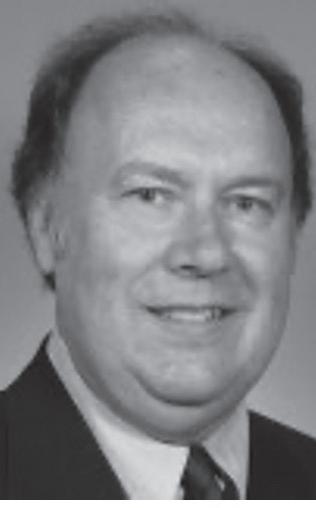
According to numbers guru Jerry Deichert, director emeritus of the Center for Public Affairs Research at UNO, these numbers are actually startling and foreboding on at least four levels.
The first is the strain on the state’s Medicaid system.
Here’s another number to consider. 60. Sixty is the percent of nursing home residents in Nebraska who rely on Medicaid for their long-term care. Medicaid is the combined federal-state health insurance program for lowincome residents. While it provides coverage for families and individuals of any age, the most expensive part of Medicaid on a per-person basis is nursing homes. And about 30 percent of the long-term care facility beds, or 4,833, are in the five counties served by the Eastern Nebraska Office on Aging (ENOA), as reported by the Nebraska State Unit on Aging. Consequently, as the population ages, the demand for nursing home care could increase exponentially. Medicaid is already a $4 bil-
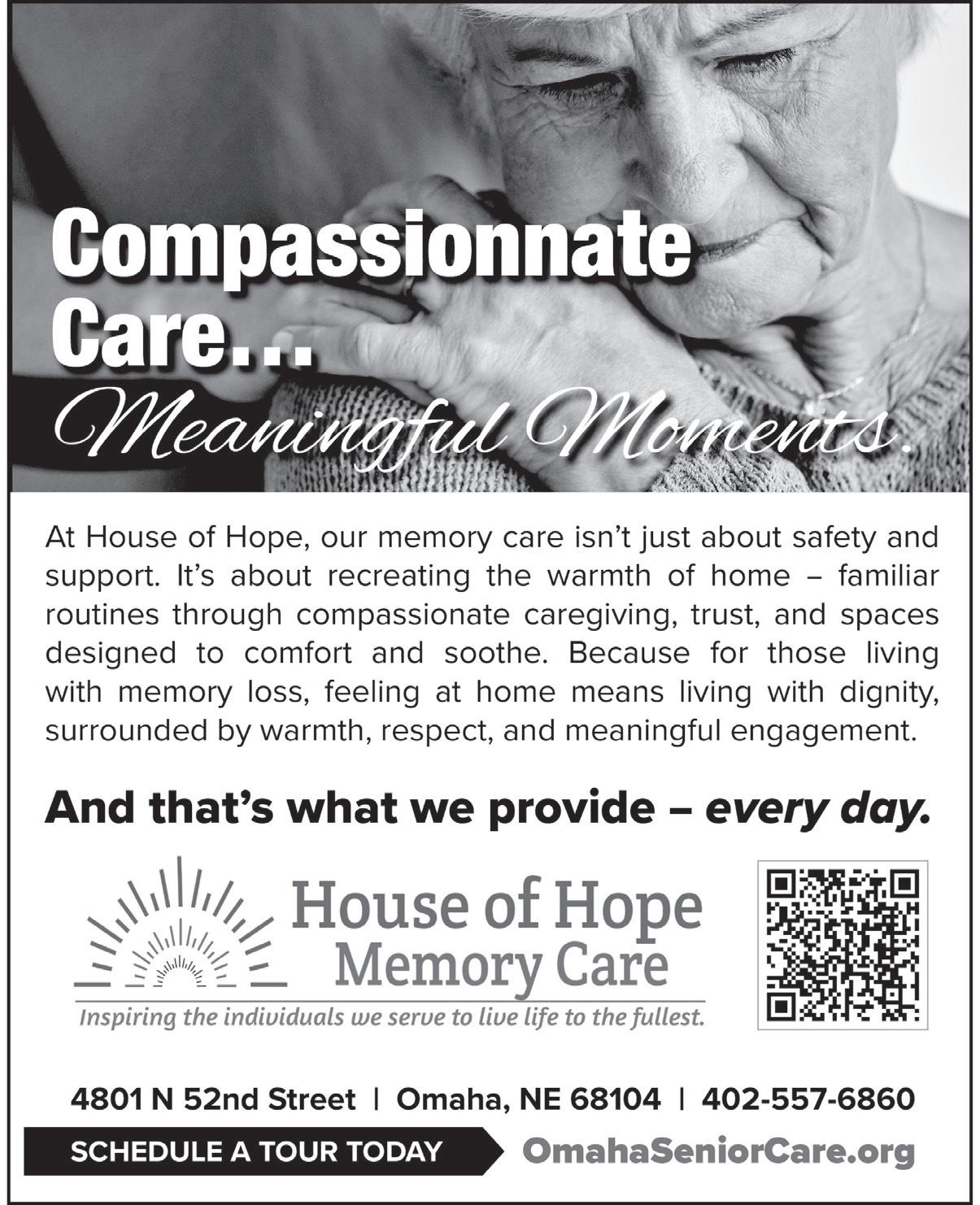
lion state expense, although just 17 percent of that is spent on services for qualified older recipients, according to the latest information from the Nebraska Department of Health and Human Services.
In fiscal year 2020, preCovid, Nebraska spent $244,000 a month for Medicaid services. In fiscal year 2024, $364,255 was spent, a 45 percent increase.
Medicaid eligibility is tight, and many cashstrapped individuals will liquidate assets in order to qualify.
For a single person, monthly income cannot exceed about $1,200 a month, and assets (including bank accounts and investments) are generally limited to $4,000.
State senators have grappled for years with the growing burden of Medicaid expenditures on the state’s finances, made even more arduous by recent federal modifications in Medicaid disbursements to states.
National, regional and local experts have argued for years that enhancing in-home community-based services, sometimes referred to as “aging in place,” is an important step to reigning in Medicaid costs in the state.
Writing seven years ago in a 2018 policy briefing, Deichert stated, “the most efficient way to save costs in the Nebraska Medicaid program is to delay or eliminate the need for nursing home placement.” He added, “The most effective way to do this is to develop alternatives to nursing home placement with home and community-based services,” such as those provided by ENOA.
The second implication behind the burgeoning numbers of aging Nebraskans is the strain on the availability of necessary services, including housing, transportation, and medical care.
In the metro area, housing alternatives for seniors appear to be growing exponentially, but availability may still struggle to keep up with the demand for independent living, assisted living, memory care, as well as all types of long-term care.
“A lot of those places have waiting lists to get into, even as soon as they’re built,” said Deichert.
Nationwide, an estimated 609,000 new senior housing units will be needed by 2030 to meet rising demand,
according to PERE, a global real estate industry news publication.
Transportation is also a challenge, especially in rural communities, as service providers trim transport options and public transportation is limited or nonexistent. Many residents learn to rely on family and volunteers to shuttle them to medical appointments, shopping, and other outings.
“You have 80-year-olds driving 90-year-olds to medical care,” Deichert said.
The third serious implication lurking behind the phenomenon of an aging population relates to worker shortages. As the demand for housing, long-term care, community-based services and transportation escalates, so does the demand for a trained and qualified workforce.
Yet, despite efforts and incentives throughout the state to entice more people to work in nursing facilities, labor shortages remain chronically high, especially in rural areas.
According to a 2024 report from the American Health Care Association (AHCA), “the nursing home sector, despite ongoing investments, is struggling to rebuild its workforce and recover from the pandemic.”
Among other findings, the report stated that nearly all facilities surveyed report difficulties recruiting new staff, despite having increased hiring bonuses; more than two-thirds label the challenge as “an extremely big obstacle.”
And nearly half of the institutions surveyed are now limiting new admissions, and many are turning applicants away altogether.
Nebraska is no exception.
Fifteen Nebraska counties have no nursing home or assisted living facility, which has created a “care desert,” according to the Nebraska Health Care Association (NHCA).
Sixteen have closed in the last four years, including eastern Nebraska facilities in Hooper and Dodge, according to NHCA.
“Access to care in these settings is becoming increasingly limited due to a tight labor market, rapid inflation causing the cost of goods, services, and labor to soar, and a historical lack of adequate funding for services provided,” according to NHCA president and CEO Jalene Carpenter, who addressed these issues during a
news conference at the state capitol last year.
The state’s long-term care facilities have raised wages as much as 30 percent, according to Carpenter, but many of the state’s 196 nursing homes are “still limiting admissions because of staffing shortages,” she said. “It’s unsustainable.”
Carpenter said part of the problem is that the “population of seniors who need care in many rural areas outpaces the supply of working-age adults.”
The final serious ramification of an aging population – decreased state revenues to fund necessary services and supports for the long haul.
Recent state budgeting projections from the Nebraska legislative fiscal analyst suggest that a budget deficit of $95.5 million will be encountered next year, with that deficit approaching $217 million over a two-year period. This is due primarily to a combination of lower cash revenues and reduced federal aid, as reported by the Nebraska Examiner in July.
As more older Nebraskans exit the workforce, less revenue in the form of state payroll taxes is generated. As seniors reduce spending on high-ticket items such as vehicles and furniture, less sales tax revenue is generated. And due to recent legislative action, Social Security revenue is no longer taxed at the state level.
“The sales taxes and income taxes at the state level collected from each person is going to get smaller as we age,” predicted Deichert.
Deichert believes the four serious consequences outlined here arise because policymakers have not taken a long-term view when addressing the future needs of Nebraska’s aging population.
“We’re wholly not prepared,” Deichert said. “We just don’t think long term. It’s what’s going to happen today, next week or maybe next year, but we don’t think about what’s going to happen in five to 10 years. We don’t prepare for it . . . we’ve been sitting around not really realizing what is going to happen.”
Deichert said this is true at both the local and state levels. “The question is, are we prepared for what comes next . . . all of a sudden, we’re going to get hit, and we’re just not ready for it.”
Taking a look back at an old

In this October 1977 issue of the New Horizons, the Eastern Nebraska Office on Aging (ENOA) is looking for more volunteers to deliver meals.
Many air travelers turn to TSA PreCheck for its quickness and ease. TSA PreCheck is a US airport screening program that allows you to get through airport security with fewer steps and without waiting in long lines. But cybercriminals take advantage of this tool to trick travelers. In this scam, you receive an email that appears to come from TSA PreCheck. The email encourages you to enroll or renew your membership and provides a link to
what looks like the official TSA PreCheck website.
The website promises you can skip the long security lines at the airport by paying a fee. However, this website is a fake version of the real TSA PreCheck website. If you enter any money or financial information here, the scammers will be able to see it immediately.
For more information, visit KnowBe4. com.
By Mike Carsey Volunteers Assisting Seniors
If you are currently enrolled in a Medicare Part D drug plan or a Medicare Advantage plan, in September, you received a document from the plan called the Annual Notice of Change. This document lists, side by side, the changes in your plan from 2025 to 2026.
Kaiser Family Foundation research in September, 2024, showed that 7 out of 10 Medicare beneficiaries do not review their Medicare Advantage plans or stand-alone Medicare Part D plans. Coverage and costs vary widely from plan to plan. Not reviewing your plan each year could lead to unexpected and avoidable costs and disruptions for you.
Volunteers Assisting Seniors helped over 2,000 beneficiaries review their plans last year. The appointment results in you knowing that you have done the best you could to ensure that you have a Medicare Part D or Medicare Advantage plan that best fits your needs for 2026.
Volunteers Assisting Seniors offers free, unbiased information and assistance in reviewing your Part D drug plan or Medicare Advantage plan. Our counselors are not insurance agents nor do they sell any products.
This year, Volunteers Assisting Seniors will offer in person appointments at our office Monday –Friday, as well as offsite, in person counseling events in Douglas, Sarpy, Cass, Dodge, and Washington Counties.
Medicare beneficiaries often have many questions about the Annual Open Enrollment Period. Here are some of the most frequently asked questions, accompanied by answers.
MEDICARE ANNUAL OPEN ENROLLMENT: WHAT ELSE DO I NEED TO KNOW?
Each year Medicare beneficiaries can take advantage of the Medicare Annual Open Enrollment


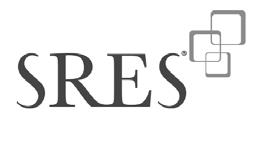
Period to review their Medicare Advantage plans or Medicare Part D drug plans.
The open enrollment period begins October 15, 2025 and ends December 7, 2025.
WHAT PLAN CHANGES CAN I MAKE DURING THIS PERIOD?
• Switch from one Medicare Advantage plan to another Medicare Advantage plan.
• Switch from one Medicare Part D prescription drug plan to another Medicare Part D prescription drug plan.
• Enroll in a Medicare Part D prescription drug plan if you did not enroll when you were first eligible for Medicare. If you have not maintained other creditable coverage, a lateenrollment penalty may apply.
• If you are enrolled in Medicare A and B, you can enroll in a Medicare Advantage plan. The drug benefit in the plan may be subject to a late enrollment penalty if you did not enroll when you were first eligible and have not maintained other creditable coverage.
HOW CAN I GET FREE, UNBIASED HELP IN EVALUATING MY PLAN?
It seems like someone is always trying to sell me something. During the Open Enrollment Period, Volunteers Assisting Seniors will provide in office in person counseling opportunities, in person events at various locations, and phone counseling appointments to assist you in reviewing your plan. Counselors are trained and certified by SHIP (State Health Insurance Assistance

Program) which is part of the Nebraska Department of Insurance. Unbiased information is provided to enable you to make the best decision based on your situation.
WHAT IF I DO NOTHING? WHAT HAPPENS TO MY MEDICARE ADVANTAGE PLAN OR MY MEDICARE PART D DRUG PLAN?
If you do nothing, your current plan will roll over automatically for 2026. No action on your part is required. The effective date for your plan will be January 1, 2026.
IF I HAVE A MEDICARE PART D DRUG PLAN, WHY SHOULD I REVIEW IT WITH VOLUNTEERS ASSISTING SENIORS?
SHIP certified counselors can assist in reviewing your plan and help you determine whether your plan is the best option in 2026. The four most common reasons for beneficiaries making a change in plans are:
1. That there will be changes in prices to the medications you take in 2026.
2. That there will be an increase in the premium in your current plan in 2026.
3. That you have discontinued medications or added new medications during 2025.
4. That your current plan may be discontinued and no longer available in 2026.
IF I HAVE A MEDICARE ADVANTAGE PLAN, WHY SHOULD I REVIEW IT WITH VOLUNTEERS ASSISTING SENIORS?
Medicare Advantage plans combine Medicare Part A, B and usually Part D drug coverage, in one plan. The plans can also offer services not typically covered by Medicare such as hearing, vision, and dental services. There are two basic components to a Medicare Advantage plan: Health and medication. When you partner with Volunteers Assisting Seniors certified counselors, we help you determine a plan with the broadest possible network of providers, including the providers you currently use, and the least expensive medication
option, all in one plan. The purpose of the Annual Open Enrollment Period is to allow you to review your plan to be sure it is the best plan for you during the following year.
WHEN BENEFICIARIES ATTEMPT TO REVIEW MEDICARE ADVANTAGE PLANS BY THEMSELVES, WHAT IS THE MOST COMMON MISTAKE MADE?
Often beneficiaries are persuaded to change plans because of information seen on TV ads or received in the mail promoting gym memberships, transportation, and other non-direct health related benefits.
Beneficiaries who change plans for these reasons often do not consider the impact of a plan change on their medication costs or their provider networks. While these extra benefits can be important factors, the counselors at Volunteers Assisting Seniors can help you sort through the details of plan benefits prioritizing the network of providers you need and the cost of the medications you take.
IF
PLAN, DO I NEED TO CONTACT THE PLAN TO RENEW MY COVERAGE FOR MY HEALTHCARE?
No, Medicare Supplement plans are not affected by the open enrollment period. If you continue to pay the premium for the supplement plan, the coverage remains in effect. You do not have to contact your plan.
Follow Volunteers Assisting Seniors on Facebook at “VAS Nebraska.” Information about Medicare and Fraud are included. “Fraud Friday” is a feature providing the latest information about phone and email scams as well as other information about fraud. Call today: Contact Volunteers Assisting Seniors for your appointment or more information 402-4446617. We have moved to a new address: Volunteers Assisting Seniors 900 South 74th Plaza, Suite 403 Omaha, Ne 68114.
Public health officials are urging Americans to take steps to protect themselves and others as flu season approaches, with vaccination highlighted as the most effective way to reduce illness, hospitalizations and deaths.
The Centers for Disease Control and Prevention (CDC) recommends that everyone aged six months and older receive a flu vaccine each year, ideally by the end of October. For the 2025–2026 season, all flu vaccines are designed to protect against three influenza viruses. A vaccination is especially critical for high-risk groups including young children, older adults, pregnant women, and people with chronic health conditions such as asthma, diabetes, or heart and lung disease. Health care workers and caregivers in longterm care facilities are also strongly encouraged to get vaccinated to protect vulnerable populations.
Preventive measures such as covering coughs and sneezes, washing hands frequently, and wearing masks can further reduce transmission. Those who develop flu-like symptoms should remain at home for at least 24 hours after their fever subsides and their
overall condition improves. Antiviral drugs, prescribed by a doctor, can help lessen the severity of illness and shorten recovery time if taken within the first two days of symptoms.
CDC notes that people may experience fever, cough, sore throat, runny nose, headaches, fatigue, and, in some cases, vomiting and diarrhea. Because flu symptoms can overlap with COVID-19 and the common cold, individuals are advised to seek medical guidance when in doubt.
Precautions that can be taken to protect others from respiratory illness. These include taking steps for cleaner air and hygiene practices like cleaning frequently touched surfaces. More information is available about core and additional prevention strategies. Cover coughs and sneezes.
Cover your nose and mouth with a tissue when you cough or sneeze. Throw the tissue in the trash after you use it.
Wearing a mask is an additional prevention strategy that you can choose to further protect yourself and others. When worn by a person with an infection,
masks reduce the spread of the virus to others. Masks can also protect wearers from breathing in infectious particles from people around them.
Wash your hands often with soap and water. If soap and water are not available, use an alcohol-based hand rub.
Avoid touching your eyes, nose, and mouth. Germs spread this way.
You can improve air quality by bringing in fresh outside air, purifying indoor air, or gathering outdoors. Cleaner air can reduce the risk of exposure to viruses.
Take flu antiviral drugs if your doctor prescribes them. If you are sick with flu, antiviral drugs can be used to treat your illness.
Antiviral drugs are different from antibiotics. They are prescription medicines (pills, liquid or an inhaled powder) and are not available over-the-counter. Flu antiviral drugs can make flu illness milder and shorten the time you are sick.
Learn about some of the similarities and differences between flu and COVID-19, and the difference between flu and the common cold.
(The CDC provided this information).
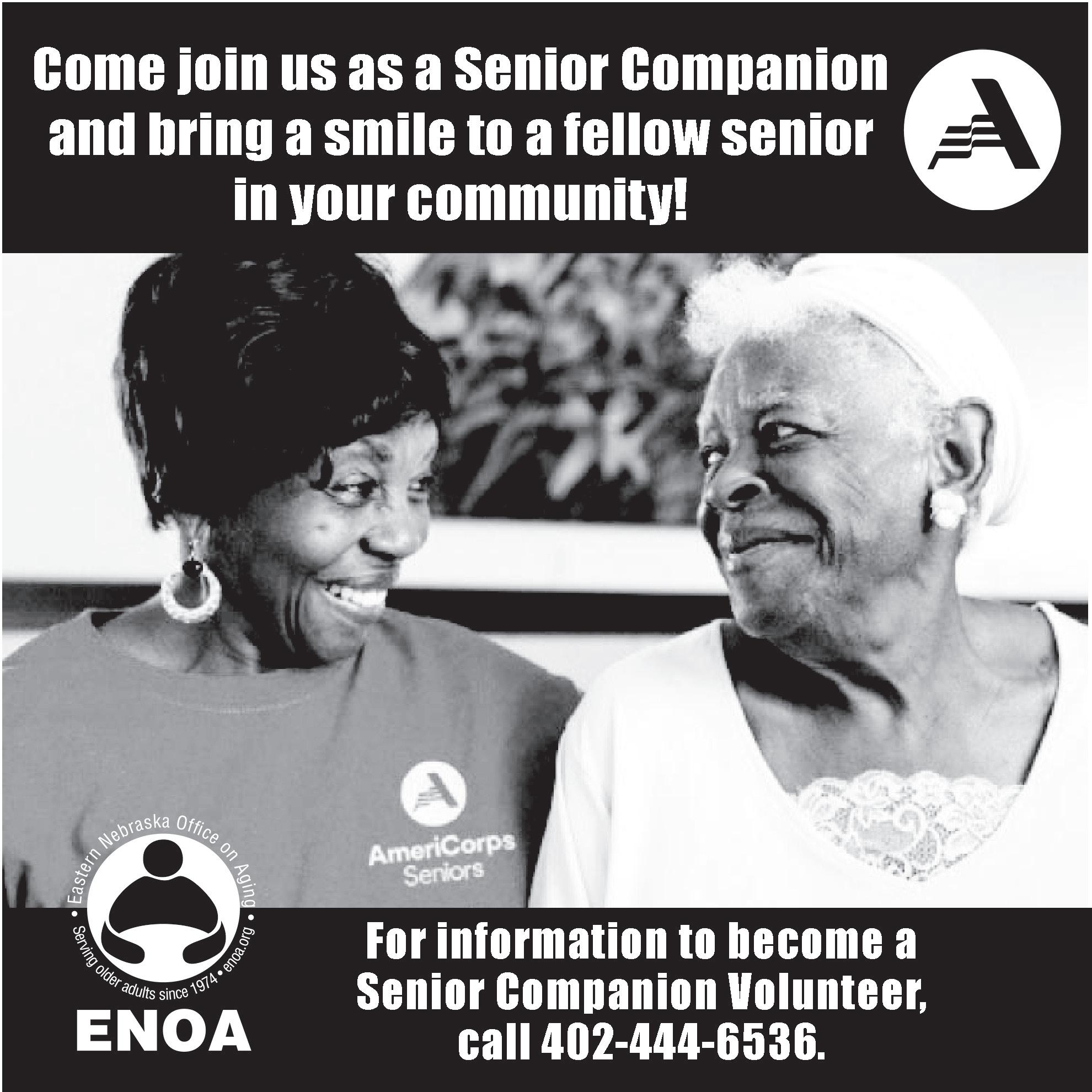
Have you ever seen an ear growing out of a tree? Gray fingers sticking out of the ground? Or red cups lining the edge of the trail? These fascinating fungi – and more are all at the Fontenelle Forest. Join a Naturalist Educator and a member of the Nebraska Mycological Society as they explore the myriad of mushrooms that grow throughout the year. Bring your hiking boots, a water bottle, and a sense of adventure as we traverse easy-to-moderate terrain looking for fungus.
For more information, visit the Fontenelle Forest website at fontenelleforest.org.
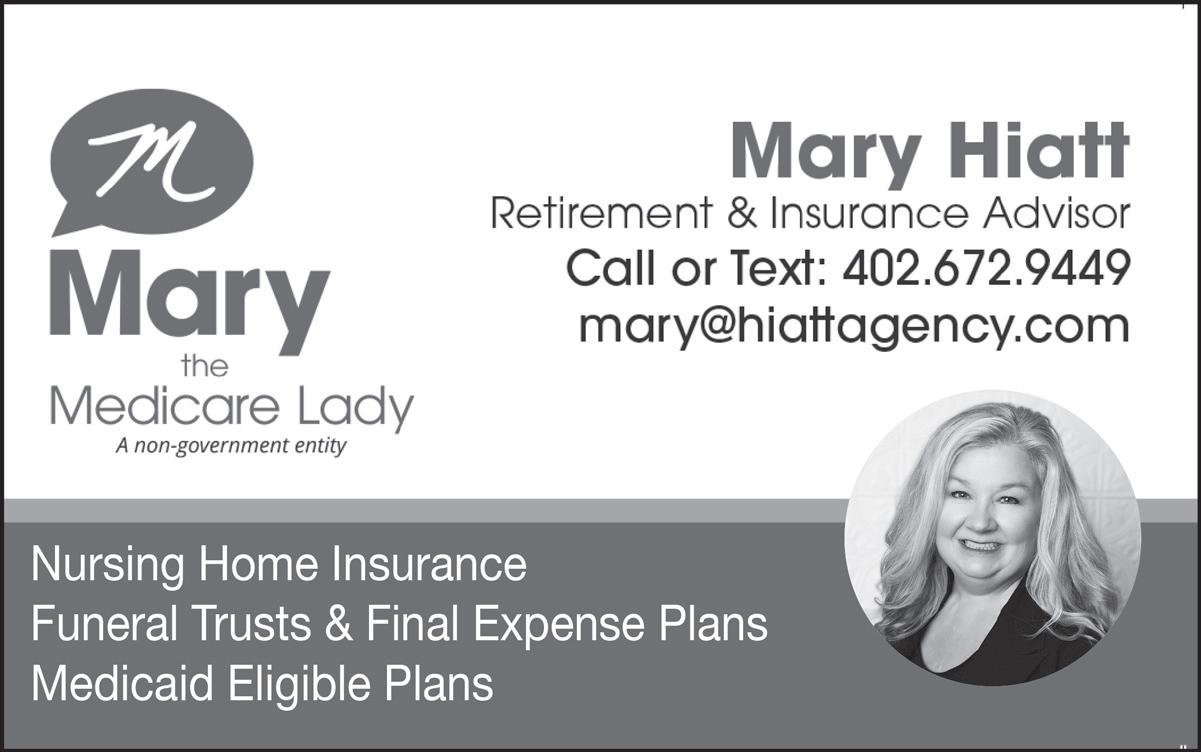
Personalized moving solutions designed specifically for seniors and their families.

• We Organize pre-move
• Move our Clients
• Mediate Family Issues
• Prepare assets for online auction
• Real Estate Broker
• Licensed Federal Firearm Dealer
• Auto Auction Dealer
• Coin Collections
• Asset Appraisal
• We love to Move Seniors
25 Years of Moving, Liquidation and
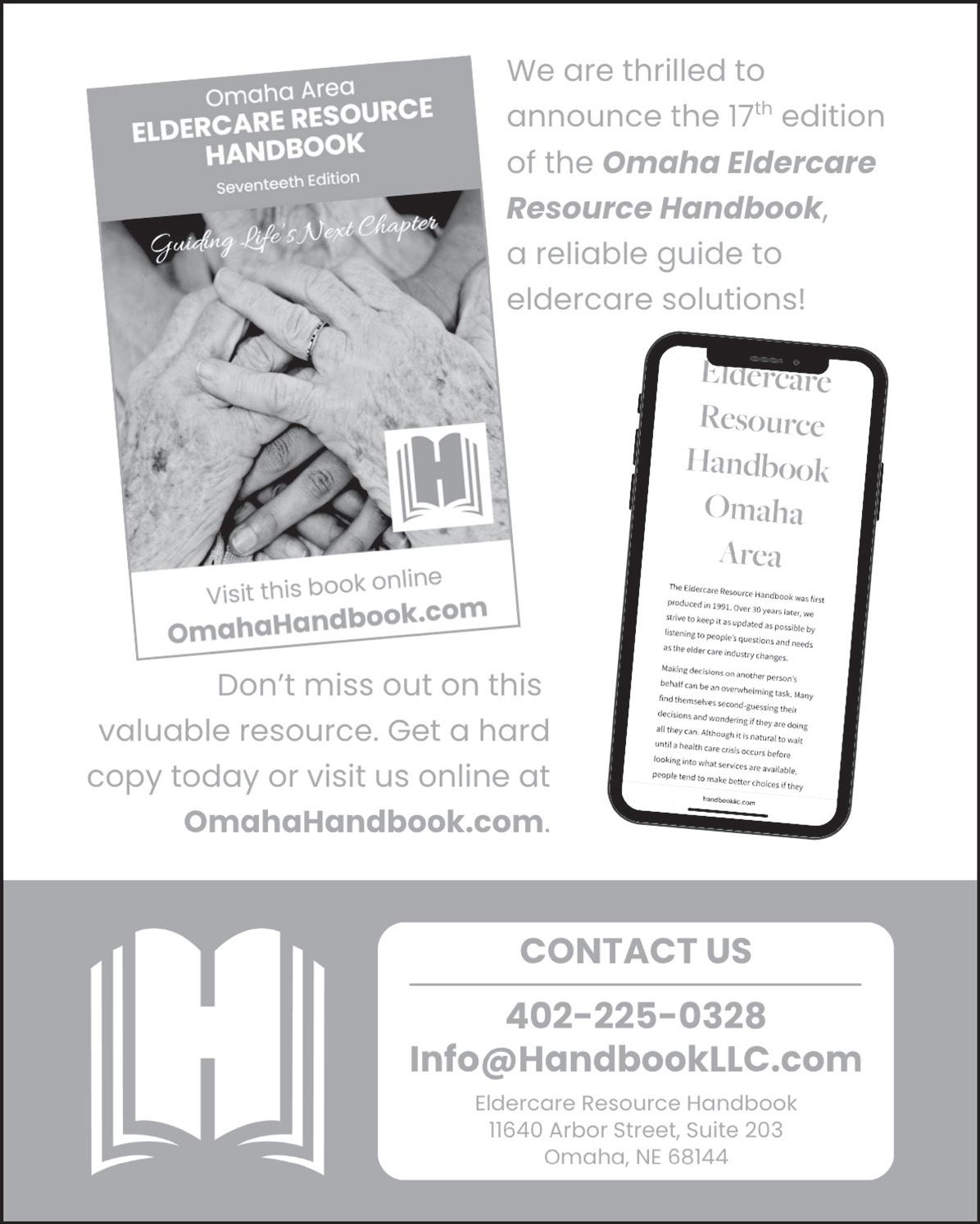
By Kelly C. Bourne
Criminals from around the world want to steal passwords for your online accounts. Examples include email accounts, bank accounts, Facebook accounts, eBay accounts, and Amazon accounts. They have many ways of getting passwords, but you can take steps to help protect your passwords.
Knowing your password lets criminals log into and take over the account. If a hacker is able to log into your account, he can change the password and lock you out. Having control of your account enables them to steal from you.
Cybercriminals are able to steal assets from bank accounts, retirement accounts and even frequent flyer accounts. They’re even looking to steal digital assets from victim’s online game accounts.
If you have accounts with online retail stores, a hacker can make purchases and have the purchases sent to an address where he can safely pick them up.
He’ll get the merchandise and stick you with the payments.
Controlling your email or social media account is also valuable to a criminal.
A hacker can use your account to communicate with your contacts and scam them. They can glean through your old emails looking for personal information like credit card numbers, passwords, and financial details that can be exploited.
If a hacker can accumulate enough personal data about you from the accounts he can access, then he can commit identity theft. He
will apply for new credit cards, take out loans and open accounts with online merchants in your name. He’ll max out those accounts and you may be stuck paying for it.
Some criminals don’t steal from you directly. They choose to sell your account IDs and passwords on the Dark Web.
Criminals will purchase your credentials and steal from you.
There are many methods that criminals use to steal passwords. In a phishing attack scammers send emails to potential victims that appear to be from legitimate sources like a bank, clergy members, friends, Amazon, eBay or a government agency. The email may claim that your account has been compromised or locked. To correct the problem, you’re instructed to click on a link in the email and log into the account. The link leads to a website that looks legitimate but is controlled by criminals. If you log into it, they’ll capture your ID and password.
Never trust a link included in an email. Always enter the site’s URL into a browser yourself or use the “Favorites” feature of the browser to get to authentic websites.
Social engineering attacks are another way to trick victims. The scammer may call, text or email you pretending to be a technician from Microsoft, customer support from Facebook, a law enforcement officer or a bank official. They’ll have a convincing story explaining why you should reveal your
account ID and password. The story may be that they need this information to protect your account, correct a problem with your computer, or to catch bad guys.
Don’t believe them! No legitimate business will ever ask you to reveal your password.
Another way criminals get victims’ passwords is to infect a file with malware and attach it to email.
The email will try to convince recipients that they need to open the attachment. If you open it, malware will be installed on your computer or phone.
The malware might be a virus, ransomware or a keystroke logger. Whatever type of malware it is, its goal will be to steal your assets or personal information. This type of attack can be prevented by never opening an attachment unless you confirm with the sender that it is legitimate.
WHAT TO DO IF YOUR PASSWORD IS STOLEN
If you’re the victim of a password scam, change all affected passwords immediately! This might involve multiple accounts. When creating a new password make sure to pick a strong one and never use the same password for multiple accounts.
New passwords shouldn’t be a variation of the old password, for example by adding a “1” to the end of it.
HOW CAN YOU DETERMINE IF YOUR PASSWORD HAS BEEN STOLEN?
• The password that should allow you to log into an account isn’t working.
• You receive notifications
that the account was logged into, and it wasn’t you.
• You receive a data breach notification letter from one of your account vendors that your credentials have been exposed.
• Security tools like HaveIBeenPwned or The Stolen Password Scanner can indicate that your password has been found on the Dark Web.
Some password managers will also notify you if your account credentials have been compromised in a data breach.
TO
HAVING YOUR PASSWORD STOLEN
• Have strong, unique passwords for every account. If the same password is used for multiple accounts, then if a criminal is able to access one account, he gains access to all of them.
• Never click on links in unknown emails! Criminals frequently send out emails or texts telling victims that their account has been compromised or locked.
If you hover over a link, you can see the actual web address it will take you to. Scammers frequently create an address that differs from the real one by only a letter or two.
• Legitimate companies and government agencies will never call you unexpectedly. Don’t trust anyone if you didn’t initiate contact with them.
• Emails or texts that pressure you into acting immediately are always scams.
• Set up multi-factor authentication (MFA). It can protect your account even if a criminal has the password.
• Limit the personal
details you post on social media. These details can be clues to your password. Personal information can be used to help social engineers convince you that they have similar interests or that they’re someone you can trust.
For example, if you have many posts about golfing, they might send you an email with an attachment that promises free or discounted rounds of golf.
The attachment really contains malware.
• Never share your passwords with anyone. No legitimate company representative will ever ask you for your password.
• Never allow anyone to remotely control your computer. Allowing this will let them steal from you.
• Using a password manager allows you to have unique, strong passwords for all your accounts.
• Never believe or trust any communication that you didn’t initiate.
It’s a sad reality but we live in a world where it isn’t safe to trust strangers. If you’re contacted by someone you don’t know personally there is a significant chance it’s a scam.
If your gut tells you that something is wrong, then trust your instincts and hang up or ignore the text or email.
The old saying “better safe than sorry” has never been more applicable than today.
Kelly’s newest book, “Ransomware, Viruses, Social Engineering and Other Threats: Protecting Your Digital Assets” is available on Amazon and at The Bookworm.
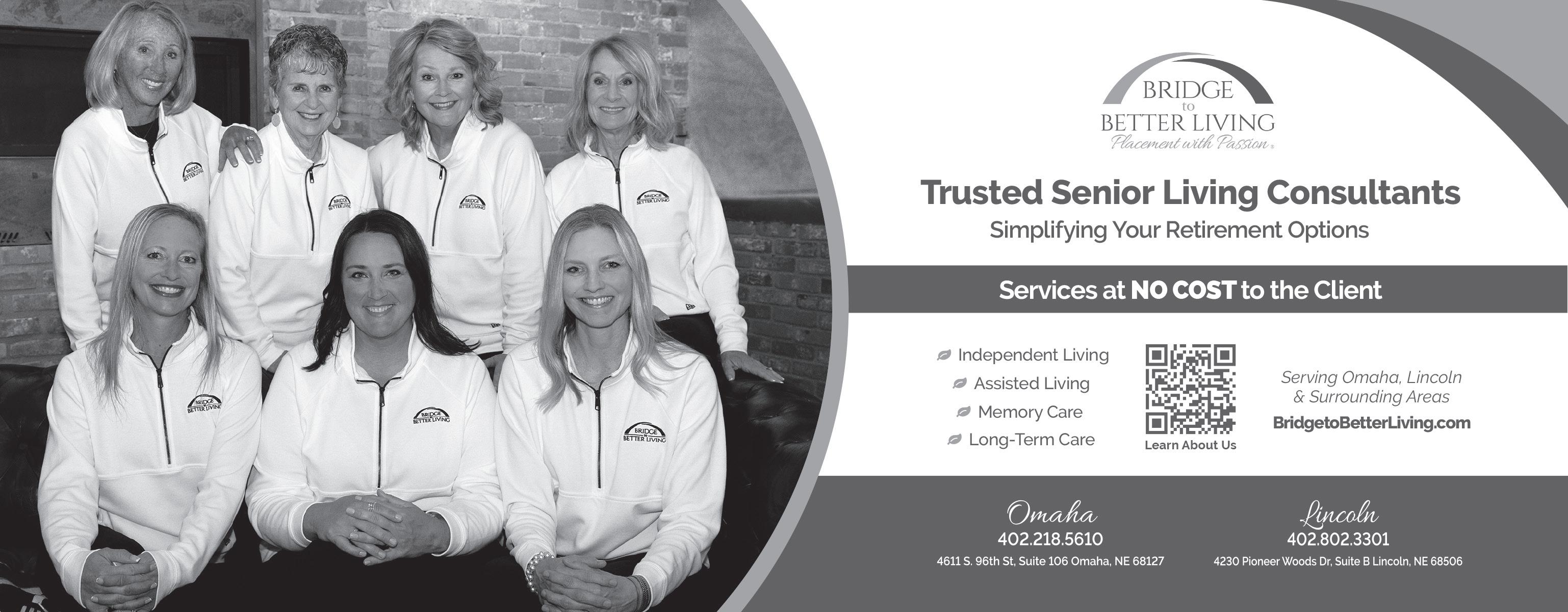
Join Flaherty Senior Consulting for a series of Solutions Group gatherings that will address the questions and challenges caregivers face.
Solutions Groups provide opportunities for caregivers to learn how to deal with various issues, obtain skills and knowledge, engage in discussions, and interact with others in similar circumstances.
Upcoming meeting dates and locations are:
• Oct. 2, Dec. 4, Feb. 5, April 2, June 4, Aug. 6, Oct. 1, Dec. 3
The Servite Center of Compassion 72nd St. and Ames Cr.
• Oct. 15, Dec. 17, Feb. 18, April 15, June 17, Aug. 19, Oct. 21, Dec. 16
St. Timothy Lutheran Church 93rd and Dodge streets
• Nov. 11, Jan. 13, March 10, May 12, July 14, Sept. 8, Nov. 10
St. Vincent de Paul Church 14330 Eagle Run Dr.
• Nov. 15, Jan. 24, March 28, May 16, July 25, Sept. 26, Nov. 28 Faith Westwood United Methodist Church 4814 Oaks Ln.
The Solutions Groups are facilitated by Nancy Flaherty, MS, CDP, president of Flaherty Senior Consulting. She has extensive experience working with family caregivers and caregiver groups.
For more information, email Nancy at flahertyconsulting@cox.net or call/text her at 402-312-9324.
The School of Pharmacy and Health Professions at Creighton University is conducting a research study, is looking for older adults with sarcopenia.
The goal of this research study is to provide evidence for the use of internal and external cues to optimize resistance training within rehabilitation.
This study requires three in-person visits at Creighton University. Sessions will last 1.5-2 hours each and each session will be separated by seven days.
You may qualify if you are 60-95 years of age, are physically independent and if you have reduced muscle mass.
You should not be in this study if you have known neurological, circulatory, or edema pathology. Or if you have had a lower extremity injury or surgical intervention within the last six months, if you have participated in a structured resistance training program within the last 12 months or if you have severe cognitive impairment.
If you are interested, please call Rashelle Hoffman at 402-280-5691 or email movecoglab@creighton.edu.
Life can bring on stress for many of us. Finding ways to relieve stress is important to our overall health and wellbeing. Caregivers are not immune to this stress.
Please contact Respite Across the Lifespan at edbennett@unmc.edu or 402-559-5732 to find out more about respite services and to locate resources in your area.
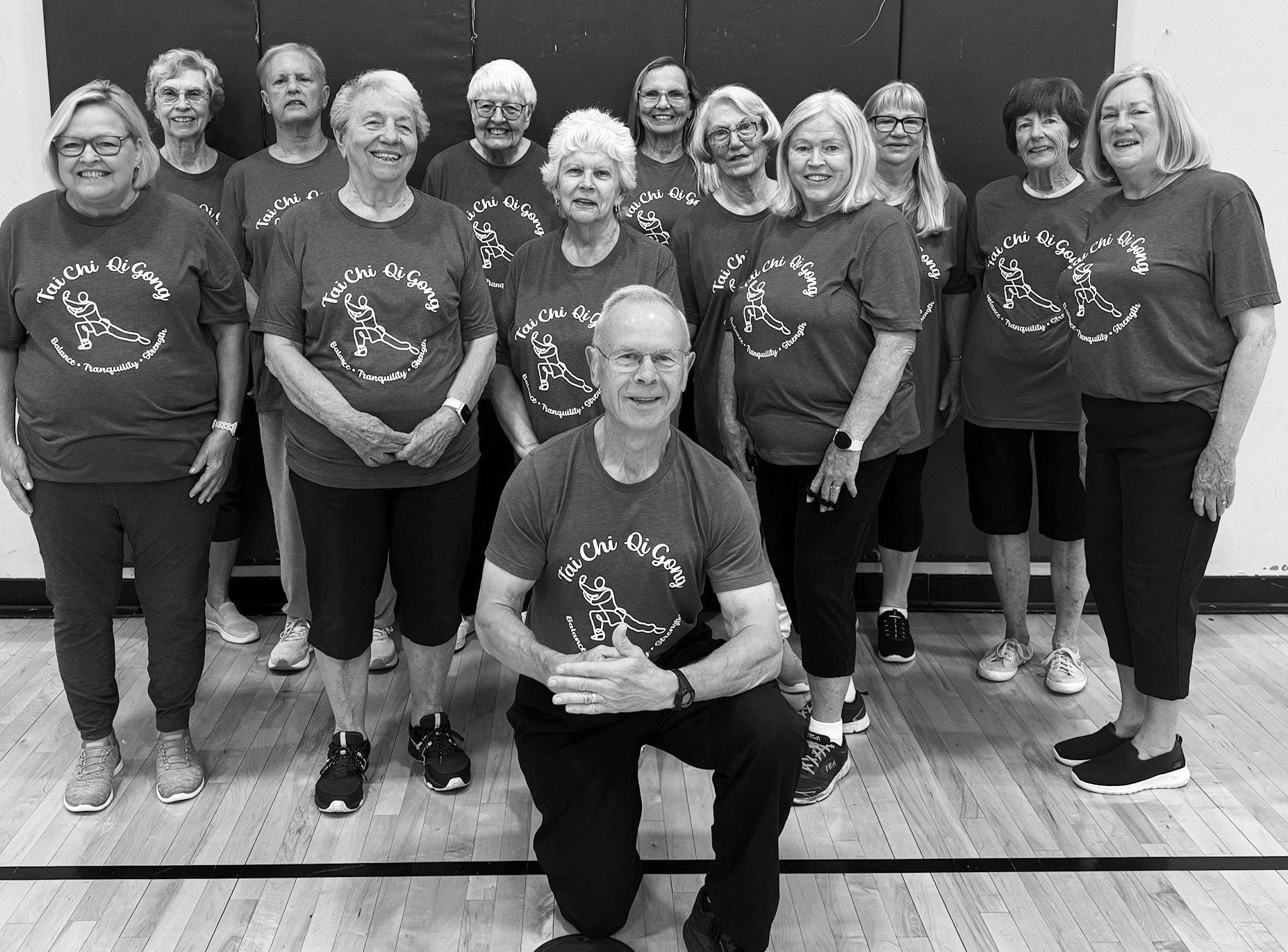
Tai Chi is an ancient Chinese practice that combines physical movements, breathing techniques, and meditation. It is considered a form of mind-body exercise that promotes physical and mental well-being. If you are looking to give Tai Chi a try, visit the Montclair Senior Center for Tai Chi every Monday and Friday from 9:30-10:15 a.m.
Connect with the Eastern Nebraska Office on Aging (ENOA) on LinkedIn.
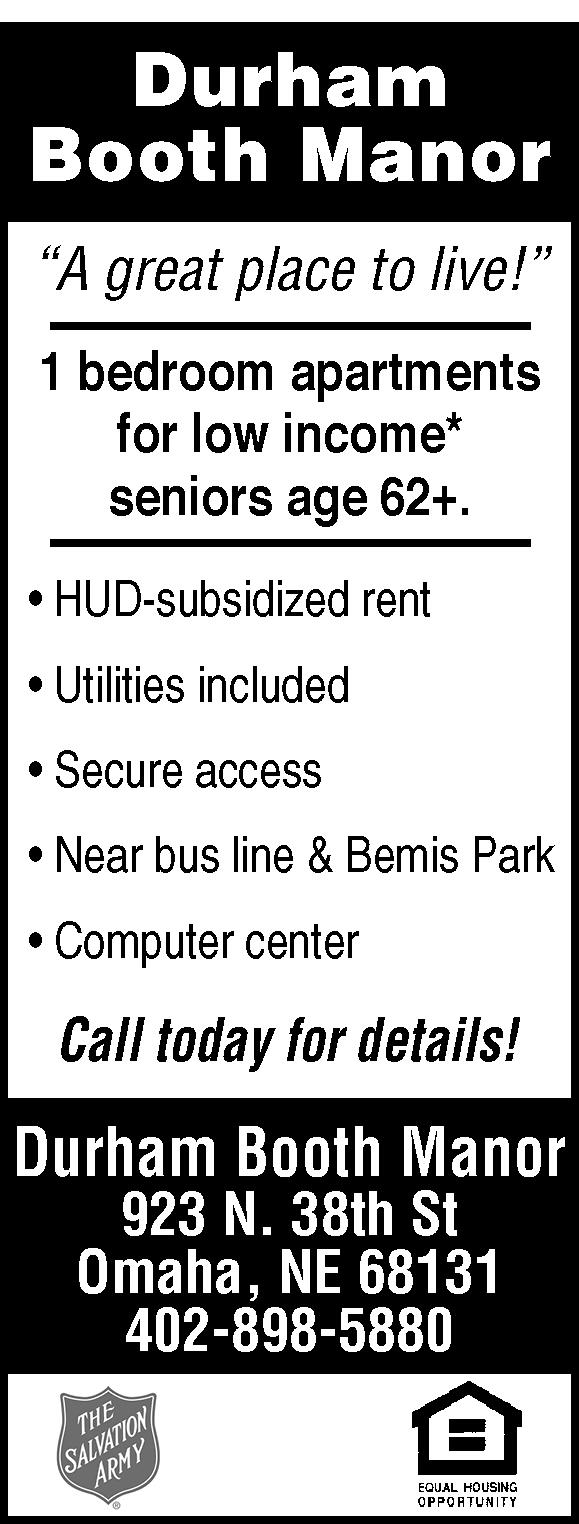
deFreese Manor
HUD subsidized One-bedroom apartments for seniors 62 and over, or disabled. Waitlist is open
2669 Dodge | Omaha, NE 402-345-0622

TTY/TDD: 711





By Ron Petersen
The pandemic upended lives and livelihoods across the country, forcing consumers to adopt to new purchases and hobbies.
Homebound consumers abandoned ingrained shopping habits, hurtling ecommerce into hyperdrive and compressing a decade’s worth of digital adoption into 100 days.
With the help of the internet, one shopping habit seemed to catch fire, which was the reemergence of collecting sports cards.
“There was a lot of free money — cards were going for thousands of dollars and a lot of new people were coming into the hobby,” The Card Shop owner, Scott Miller said. “When a new collector comes in, we ask what they are looking for. Collect something that means something special to you. If you are going to collect a card, then it is going to have to mean something to you.”
Baseball trading cards have been around since the 1860s and have evolved over time.
The cards were primarily used for advertising and were often black-and-white photographs or color prints.
They became popular over time. The T206 Honus Wagner card, published between 1909 and 1911, is considered one of the most valuable baseball cards in history. In August 2021, the card sold for $6.606 million.
Other sports including football, basketball, soccer and hockey grew in popularity during the 1900s, especially for Scott Miller.
“I started collecting hockey cards in 1979 and down the rabbit hole I went,” Miller said. “There were only a handful of people collecting hockey cards in town. I went to card shows and I eventually opened up a card shop.”
Miller opened his very own sports cards shop in 2001, sold it in 2005, but he eventually bought it back in 2014.
Miller said that collecting sports cards is perfect for anyone who is looking to build a collection or would like to make an investment

There are many ways to trade sports cards these days, and plenty of places to find them.
at 4725 S 131st St is a great place to start investing in sports cards.
in something, which is something he noticed more people doing since 2020.
“Since the pandemic, there has been a big youth movement, especially for those with kids who have gotten into it. The older adults that collect, collects. They never sell their stuff because most collectors will sell something because something happened to them in their life,” Miller said. “Everybody has a thing — there is no right or wrong answer when it comes to collecting. You are spending your money and your time on something that means something to you. It only means something to the collector.”
There are a few types of collectors.
These collectors include set collectors, team and player collectors, vintage collecting, the flipper and the opportunist.
“A collector is someone who is collecting something or buying something because it means something to him or her. The flipper is someone who will buy a card and flip it for something else,” Miller said. “The opportunist is someone
who has a vision to find a card through a pack. People will come in looking for a box or pack. They will buy something for the player or team, and not for the collection.”
Another card shop in Omaha that sells sports cards is Omaha Sports Cards.
Omaha Sports Cards owner, Matt Myers, who has been into collecting sports cards for over 15 years, said the hobby can be peaceful and it helps him relax.
“I think it is a very enjoyable hobby that allows for a wide variety of possibilities of what to collect. Favorite team, favorite player, favorite college player, set building, as well as many others,” Myers said. “It is also a hobby that allows you to ‘invest’ or even sell off things that you do not want in order to buy more things that you do want.”
Trading cards is also an important aspect when it comes to sports cards.
Collectors who invest in sports cards often look to upgrade by purchasing graded cards, which are usually worth more than ungraded cards because they
are considered more authentic. Look for cards that have been rated by companies like the Professional Sports Authenticator (PSA).
You can also buy boxes of cards that are underpriced, open them up, and sell the valuable cards individually.
“People will bring in stuff and will look to trade it because a lot of people look for a player or team specifically,” Miller said. “Trading has always had its place.”
Another way collectors gain interest in sports cards is through card shows and events, which is a great way to find rare cards and network with other collectors.
“I promote one of the only local card shows in Omaha. It is only on a Sunday from 9 a.m. to 2 p.m. and we get hundreds of people through the door,” Myers said. “There is a show once a year called the National Card Convention, and they usually see over a hundred thousand people over a 4-day show.”
There is many ways to find card collectors to trade cards. The internet, specifically Facebook, allows people in Nebraska to trade cards with others,
locally. There is a group on Facebook with 13 thousand members in a Nebraska sports card collecting group.
“I have collectors in their 70s and 80s and kids that are barely in school. I would say the ‘average’ collector and dealer is in their mid-20s to mid-40s,” Myers said. “The three most common places to find other card collectors are at a card shop, at a card show or online places like Facebook.”
Getting into collecting sports cards is not only easy to get started, but also starts with an interest or a reason to invest in something that you are looking to buy.
“It all starts by buying a pack of cards or a single card of someone you like,” Miller said. “What you do from there all depends on what direction you would like to go. Some people hold on to cards until they pass, and others sell them as soon as they get them and everything in between. I would always do research or ask someone with knowledge in this industry before you make a large purchase, especially online.”